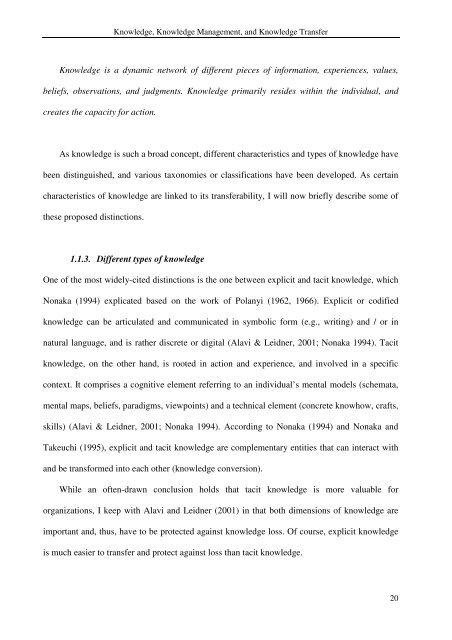thesis_Daniela Noethen_print final - Jacobs University
thesis_Daniela Noethen_print final - Jacobs University
thesis_Daniela Noethen_print final - Jacobs University
Create successful ePaper yourself
Turn your PDF publications into a flip-book with our unique Google optimized e-Paper software.
Knowledge, Knowledge Management, and Knowledge Transfer<br />
Knowledge is a dynamic network of different pieces of information, experiences, values,<br />
beliefs, observations, and judgments. Knowledge primarily resides within the individual, and<br />
creates the capacity for action.<br />
As knowledge is such a broad concept, different characteristics and types of knowledge have<br />
been distinguished, and various taxonomies or classifications have been developed. As certain<br />
characteristics of knowledge are linked to its transferability, I will now briefly describe some of<br />
these proposed distinctions.<br />
1.1.3. Different types of knowledge<br />
One of the most widely-cited distinctions is the one between explicit and tacit knowledge, which<br />
Nonaka (1994) explicated based on the work of Polanyi (1962, 1966). Explicit or codified<br />
knowledge can be articulated and communicated in symbolic form (e.g., writing) and / or in<br />
natural language, and is rather discrete or digital (Alavi & Leidner, 2001; Nonaka 1994). Tacit<br />
knowledge, on the other hand, is rooted in action and experience, and involved in a specific<br />
context. It comprises a cognitive element referring to an individual’s mental models (schemata,<br />
mental maps, beliefs, paradigms, viewpoints) and a technical element (concrete knowhow, crafts,<br />
skills) (Alavi & Leidner, 2001; Nonaka 1994). According to Nonaka (1994) and Nonaka and<br />
Takeuchi (1995), explicit and tacit knowledge are complementary entities that can interact with<br />
and be transformed into each other (knowledge conversion).<br />
While an often-drawn conclusion holds that tacit knowledge is more valuable for<br />
organizations, I keep with Alavi and Leidner (2001) in that both dimensions of knowledge are<br />
important and, thus, have to be protected against knowledge loss. Of course, explicit knowledge<br />
is much easier to transfer and protect against loss than tacit knowledge.<br />
20

















